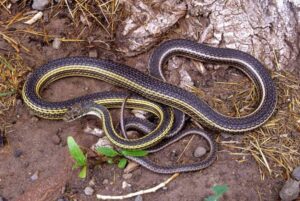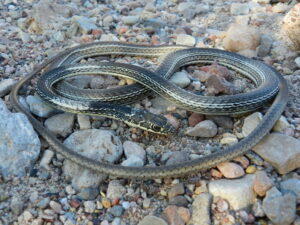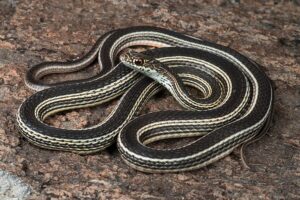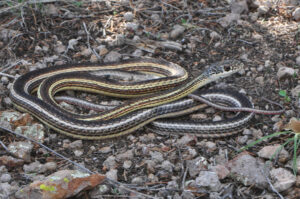The striped whipsnake is a diurnal colubrid endemic to northern Mexico and the adjacent western United States. The long, slender, and smooth snake is very alert and fast-moving. The movement is unusual as it travels across the ground with its head held high to get a good view of the surroundings. It is called a whipsnake as it resembles a leather whip in its looks.
Scientific Classifications
- Suborder:Serpentes
- Family:Colubridae
- Genus:Masticophis
- Species:M. taeniatus
Conservation Status
Subspecies
This snake has two recognized subspecies.
- Masticophis taeniatus girardi
- Masticophis taeniatus taeniatus
Description
Size
The total length of the colubrid, including the tail, is approximately 30-72 in (76-183 cm).
Color and Appearance
The striped whipsnake has a gray, black, or dark brown color on its back, often with a bluish or olive tint. A dark longitudinal stripe runs along the middle of each of the first 4 rows of the pale dorsal scales. A cream to white colored stripe occurs down the side that is bisected by a dashed or solid black line. The belly is cream to yellowish, fading to white near the head and coral pink towards the tail. A lower preocular occurs between the upper labial scales of the mouth. The snake has a divided anal scale.
Are They Dangerous to Humans
When surprised, they vanish into rocks and burrows. They can also try to escape by climbing trees. When captured, striped whipsnakes often behave aggressively and bite. But they are non-venomous and hence, harmless.
Striped Whipsnakes at a Glance
Distribution
South central Washington has the northernmost part of its distribution that continues southward into the Great Basin between the continental divide and the Cascade-Sierran crest. Then it continues southeast across the continental divide into central and western Texas and New Mexico. Michoacán, in Mexico, is where the southernmost part of its distribution lies.
In the Western US, its range also extends outside the Great Basin into northern California and the Rogue River Valley in southwestern Oregon. There is also a population in Bryce Canyon National Park in Utah.
Habitat
The striped whipsnake lives in a wide variety of habitats, including grasslands, shrublands, sagebrush flats, piñon-juniper woodlands, open pine-oak forests, and canyons. It frequents mountains as well as flatlands and is attracted to both seasonal and permanent rocky streams.
Depending on its habitat it takes shelter in small mammal burrows, rock outcrops, shrubs and trees.
Lifespan
They live for as long as 20 years.
Predators
Striped whipsnakes are preyed upon by hawks, foxes, coyotes, and other big snakes.
Diet
They eat a wide variety of animals, including frogs, young birds, small mammals, insects, lizards, and other snakes (including venomous rattlesnakes).
Reproduction
Oviparous (lays eggs that hatch outside the body)
Early spring sees these snakes courting. After fertilization, a female lays a clutch of 3-12 eggs, usually in an abandoned rodent burrow, between June and July. A study has shown that the incubation period lasts 44-58 days. The hatchlings are 14-17 in (35.56-43.18 cm) long at birth. The males become sexually mature in 1-2 years, and the females do so in 3 years.
Source
fbcdn.net, calphotos.berkeley.edu, alchetron.com, thehibbitts.net









